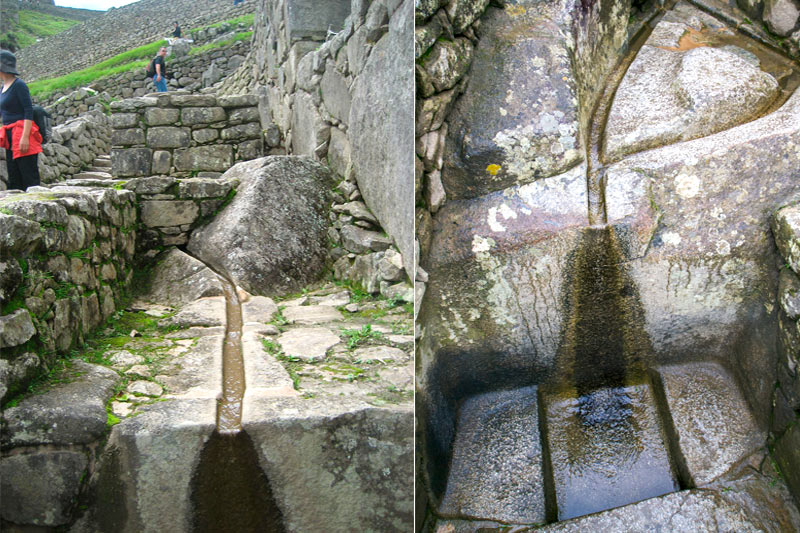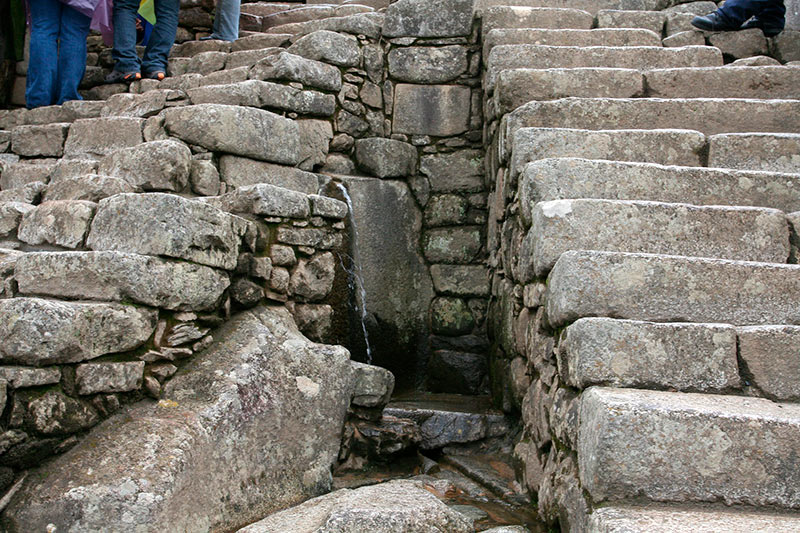Machu Picchu, example of hydraulic engineering
Machu Picchu is considered an example of hydraulic engineering. It is that the Inca city is located in the heart of the tropical jungle of Cusco, a place with copious and constant rains. In order to build a stone city, the Incas had to release all this accumulated water. It is here that they built fountains and water channels with such perfection that they still amaze researchers. Learn how to visit the famous water sources of Machupicchu!
- Machu Picchu, example of hydraulic engineering
- The water sources of Machu Picchu
- Where are they? How to get there?
- History of the water sources of Machu Picchu
- How to visit the water sources of Machu Picchu?
- What are the visiting hours?
- More information about your visit to the water sources
- Questions and answers about the water sources of Machu Picchu

Water canals in Machu Picchu
Machu Picchu was built on a geological fault with an ideal quarry for the realization of Inca constructions. However, due to its location in the high jungle of Cusco, the Incas had a difficult challenge: how to evacuate the large amount of rainfall? So they built a large network of canals and water sources. These continue to drain the water from the site to this day. Because of this, Machu Picchu is a construction that lasts through time. Get to know it!
Machu Picchu, example of hydraulic engineering
- The Incas managed to reach a high degree of development in hydraulic technology.
- As an example of their ability in water management, they built important ceremonial centers of worship to the liquid element such as: Tipón, Inkilltambo, Ollantaytambo and even Machu Picchu.
- In the Inca citadel there are dozens of ceremonial water sources considered an element of purification according to the Inca worldview.
- Perhaps the most famous water worship ceremonial construction at Machu Picchu are ‘The liturgical fountains’, also called the ‘Stairway of the Fountains’ of Machupicchu.
- However, in Machu Picchu there are dozens of fountains and water channels that fulfilled the function of venting the accumulated water, especially during the rainy season (only in January it rains approximately 2,300 millimeters).
- Furthermore, the water flowed in important enclosures such as the Temple of the Sun or the House of the Inka.
- For all this, Machu Picchu is considered an example of hydraulic engineering.
The water sources of Machu Picchu
- Machu Picchu has dozens of water sources that fulfilled the function of channeling the water that accumulates in the citadel. It also has liturgical fountains where the water fulfilled a liturgical function.
- The water sources of Machu Picchu are made of granite stone, abundant in the place. After more than 500 years, the water continues to flow in Machu Picchu without stopping.
- In 2009, four ceremonial fountains were even discovered in the eastern platform sector of the Inca citadel.
Where are they? How to get there?
- The water sources of Machu Picchu are found both in the urban and agricultural parts of the archaeological site.
- To get there, it is necessary to complete the classic circuit of Machu Picchu and visit the agricultural and urban areas.
History of the water sources of Machu Picchu
- As well as the rest of the constructions of Machu Picchu, the water sources were built by order of Emperor Pachacutec in approximately 1,450.
- In the water sources the Incas carried out purification ceremonies. It also served as a water outlet, a place where it can rain heavily throughout the year.
- Despite the abandonment of the city (in the 16th century) and the accumulation of vegetation in the archaeological site; the fountains continue to channel the water in Machu Picchu.
- Today the water sources are one of the most famous constructions of Machu Picchu.
How to visit the water sources of Machu Picchu?
- The water sources can be visited with all the tickets to Machu Picchu available: a) Machupicchu Only, b) Machupicchu with Huaynapicchu, c) Machupicchu with Mountain, d) Machupicchu with Huchuypicchu and e) Machupicchu with Inca Bridge.

Water Fountain – Machu Picchu
What are the visiting hours?
- The water sources of Machu Picchu are open to tourists every day of the year, from 6 in the morning until 5 in the afternoon.
More information about your visit to the water sources
- The House of the Inka (located below the Temple of the Sun) has waterways and its own fountain. This enclosure was intended for the Inca emperor or his royal family during their visits to Machu Picchu.
- In 2009 research work in Machu Picchu discovered four ceremonial fountains located in the eastern platform sector of the Inca citadel.
Questions and answers about the water sources of Machu Picchu
1 What are the water sources of Machu Picchu?
Machu Picchu has dozens of fountains and water channels to release the high amount of water accumulated in the rains. In addition, the Incas performed purification ceremonies in these sources.
2 Where are they?
Water sources are found both in the agricultural and urban sectors of Machu Picchu. For example, in 2009 four ceremonial fountains were discovered in the eastern platform sector.
3 How to get to the water springs of Machu Picchu?
To visit the water sources it is necessary to enter Machu Picchu and ascend to the Casa del Guardian sector. From there the walk to the urban sector is made. The fountains are best appreciated from the lower part of the citadel, in the Casa del Inka and the platform sector.
4. What ticket allows me to visit the water sources of Machu Picchu?
All entry tickets to Machu Picchu allow you to know the water springs: a) Machupicchu Only, b) Machupicchu with Huaynapicchu, c) Machupicchu with Mountain, d) Machupicchu with Huchuypicchu ye) Machupicchu with Inca Bridge.
5 Who commissioned the construction of the water springs of Machu Picchu?
According to the chronicles, it was the emperor Pachacutec who, in the middle of the 15th century, ordered the construction of the water sources along with the rest of the buildings in Machu Picchu.
6 What is the schedule to visit the water springs of Machu Picchu?
You can visit the water sources of Machu Picchu every day of the year from 6 in the morning until 5 in the afternoon.
7. What are the water sources of Machu Picchu made of?
The water sources of Machu Picchu are made of granitic stone abundant in the place (Machupicchu is located on a geological fault).
8 When is a good time to visit Machu Picchu and its constructions?
Every day of the year is a good day to get to know Machu Picchu. Most tourists prefer to do it in the dry season (from April to October) because the little rain makes outdoor tours easier.
9. Why are the water sources of Machu Picchu important?
The water sources at Machu Picchu are important because the Inca citadel is located in a rainy geography. Otherwise, the citadel would collapse. In addition for the Incas water was an element of spiritual purification.
10. What other water sources made by the Incas can you appreciate when visiting Cusco?
In Cusco there are temples dedicated to the cult of water among them: Tambomachay, Tipón and Inkilltambo. Feel free to visit them!
By Ticket Machu Picchu – Last updated, August 15, 2024